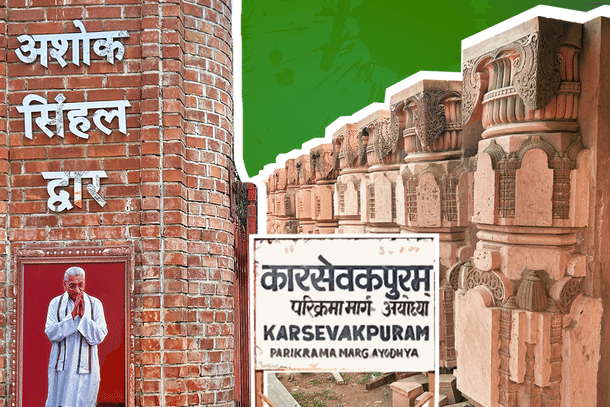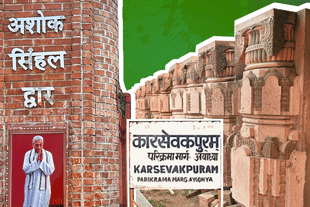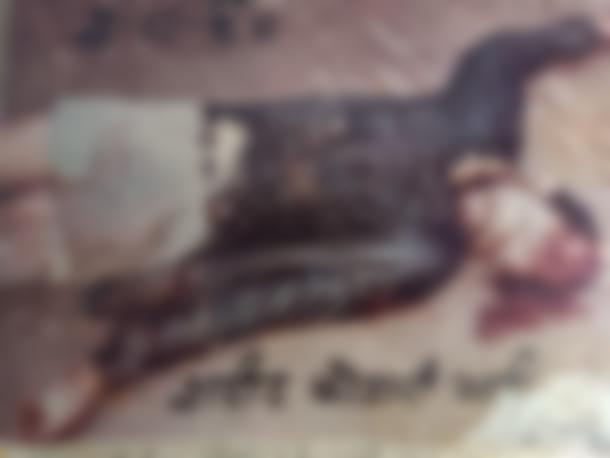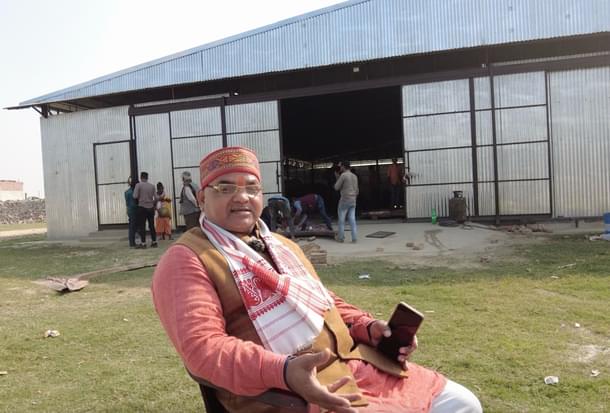Culture
Inside Ayodhya's Karsevakpuram: Once A Hideout For Karsevaks, Now VHP Office And Workshop for Ram Temple's Pillars and Murtis
Swati Goel Sharma
Dec 23, 2023, 03:00 PM | Updated Dec 27, 2023, 10:05 AM IST
Save & read from anywhere!
Bookmark stories for easy access on any device or the Swarajya app.


Three decades ago, Hazarilal Rathore, a native of Shahjahanpur district in Uttar Pradesh, permanently relocated to Ayodhya. He arrived in the city in response to a nationwide call for 'karseva' given by the Vishwa Hindu Parishad (VHP), urging devotees of Lord Ram to converge on the contentious Ram Janmabhoomi-Babri mosque site on October 30, 1990.
Like the thousands of others, Rathore chose to heed the call as an act of defiance against then state chief minister Mulayam Singh, who famously warned that ‘not even a bird would breach Ayodhya’s borders on that day’ (“Ayodhya mein parinda bhi par nahi maar sakta”) and deployed stringent security measures to prevent karsevak entry
On November 2, the police, acting on the orders of Mulayam Singh, opened fire on karsevaks for the second time in four days. Rathore, who was present at the scene, narrowly escaped death. "I witnessed the Kothari brothers being shot dead," he recalls.

As a young Swayamsevak, deeply committed to the cause of reclaiming the disputed site, Rathore made a pivotal decision to remain in Ayodhya, dedicating himself to full-time service with the VHP.
To escape arrest and firing, numerous karsevaks, Rathore included, sought refuge in a desolate area, roughly two kilometers from the Janmabhoomi site. This area, though covered with guava trees, was also known for its monkey population and lay beyond the reach of police patrols.
This secluded land rapidly transformed into a haven for karsevaks. They diligently worked to level the rugged terrain, turning it habitable. Subsequently, the VHP-backed Sri Ramjanmabhoomi Nyas, an independent trust formed in 1993, acquired nearly 45 acres of land in Ayodhya, which included this area.
It was developed into a community and, in honour of the karsevaks, named Karsevakpuram.
Today, the securely gated Karsevakpuram serves as VHP’s headquarters in Ayodhya. This complex houses the VHP office, alongside a guest house, a school, a gaushala (cow shelter), and a dining hall named Sita Rasoi.
At its entrance, where armed police stand guard, a photograph of Ashok Singhal, a former VHP president and a pivotal figure in the temple movement, is prominently displayed.
On entry, visitors are stopped by VHP workers who inquire about the purpose of their visit before granting access. Hiralal Chaudhary, who usually serves this duty, hails from Jharkhand and, like Rathore, came to Ayodhya as a karsevak in 1990.

Choosing to stay, he too found a role within the VHP. Many in Karsevakpuram originally arrived as karsevaks from various regions but ultimately made Ayodhya their home.
Rathore guards a hall near the entrance of the locality, which exhibits the first proposed model of the Ram temple, encased in glass. The original design of the temple has undergone considerable modifications and expansions since its conception. For instance, the original model proposed two floors, which has been increased to three.
Adjacent to the model, photographs of two key figures are displayed: Ashok Singhal and Mahant Ramchandra Paramhans, the former head of Digamber Akhara and leader of the Nyas.
As Rathore points towards the images, tears well up in his eyes. He says, “These two people, the most eminent leaders of our movement, deserved to witness the temple before their passing.”
Like Rathore and Chaudhary, Bholendra was drawn to Ayodhya in the early 1990s. The grievous incident of police firing on the karsevaks struck a deep chord with him.
"It felt like repetition of the Jallianwala Bagh tragedy,” he says. “But it was more disturbing. It happened after independence, and on Ram bhaktas in the land of Lord Ram.”
Moved, Bholendra felt compelled to act. "There had to be a response," he says, explaining his decision to migrate to Ayodhya.
He joined the VHP, and became instrumental in transforming Ayodhya into a "tent city" ahead of another major call for karseva given for 6 December, 1992 – the day the Babri structure fell.
Bholendra's assignment came from Champat Rai, who is now vice-president of the VHP and secretary of the government-appointed Ram Janmabhoomi Teertha Kshetra, tasked with funding and supervising the construction of the temple.
Bholendra vividly remembers the logistical challenge they faced in accommodating an expected four to five lakh people that day.
On Rai’s suggestion, he drew inspiration from how cities like Prayag manage massive gatherings during the Kumbh Mela, and conceptualised a tent-city - a setup to provide shelter to karsevaks in tents, complete with operational kitchens.
The influx of karsevaks began as early as 25 November, bringing forth new challenges. They arrived from diverse geographical regions, each with their own language. To manage this diversity, they were categorised into five regional groups or 'anchals', namely Poorvanchal, Pashchimanchal, Madhyanchal, Uttaranchal, and Dakshinanchal.
Attendees from Delhi, Haryana, Punjab, Himachal Pradesh and Jammu and Kashmir were allocated to Uttaranchal; those from Gujarat and Rajasthan were accommodated in Pashchimanchal; those from southern states like Kerala, Tamil Nadu, Karnataka, and Andhra Pradesh formed Dakshinanchal; and eastern states like Bihar and West Bengal were grouped under Poorvanchal.
In Karsevakpuram, individuals from the Madhyanchal region, covering Uttar Pradesh and Madhya Pradesh, found shelter.
The colonies were not named after these anchals but were given names such as Shivaji Nagar and Shankaracharya Nagar.
In addition to the regional colonies, which sprang up all around the Ramjanmabhoomi area, a special encampment named Rani Lakshmibai Nagar was set up for women.
VHP volunteers would transport people from the railway station and bus stands directly to their designated tent-cities.
The turnout in the days leading to 6 December exceeded initial expectations. The VHP instructed its volunteers to temporarily accommodate the karsevaks in neighbouring cities like Kashi and Prayag, delaying their arrival in Ayodhya until that day.
Similarly, those residing within a 100-kilometer radius of Ayodhya were advised to arrive in Ayodhya on that specific date.
In these tent-cities, about 16 kitchens started operations, each employing around 200 people. However, the VHP soon realised that these facilities were insufficient to meet the demands, as queues for food extended up to a kilometre.
Bholendra, noticing the issue, especially given the winter season where people might tolerate limited space but not lack of food, reported the situation to Rai. In response, the VHP issued a call to nearby areas for food donations.
"Trucks laden with puri and sabzi started pouring into Ayodhya from surrounding villages. Soon, we had more food than necessary, and the long queues at the kitchens vanished," Bholendra recalls.
The tent-cities also became hubs of spiritual activity. Prominent speakers like Sadhvi Rithambara established tents where people gathered to listen to their sermons and spent nights singing bhajans.
"There was such a strong sense of purpose and enthusiasm," Bholendra says, "that the karsevaks were determined not to return home this time without seeing the mission through to its conclusion."
On December 6, karsevaks converged on the mosque site and, using their hands and simple tools, dismantled the structure.
In Ayodhya, the Sangh members as well as the local population typically do not refer to the demolished building as 'Babri' or 'masjid.' Use of these words is often met with disdain. They call it simply 'dhancha' (structure).
Bholendra, who was present at the spot, recounts the aftermath: "Once the dhancha was brought down, chaos ensued. In the debris, some lost their lives, while many others sustained injuries."
The next day, the focus shifted to erecting a temporary temple to enshrine the murti of Ram, which had been situated under the central dome of the mosque.
The karsevaks arrived at the site in the morning and began the task of levelling the ground, removing debris by hand.
Bholendra describes the scene: “Each karsevak was eagerly picking up a rock or brick as if it were prasad. The number of people far exceeded the pieces. I saw them breaking the rocks to share. Those unable to find a piece resorted to collecting mud. Within hours, the site was cleared.”
Following this, karsevaks constructed a platform using cement, mixed by bare hands. Bamboo sticks were erected around the platform and covered with cloth.
Steps were added to the platform for access, and walls were subsequently built around it. The Ram murti was then installed on this platform, and puja was offered.
“Since December 7, 1992, Ram Lalla has been residing at the spot,” Bholendra says. “Over time, minor enhancements were made. For instance, during winters, the cloth covering was replaced with a tarpaulin sheet.”
With their aim accomplished, many karsevaks departed Ayodhya that same night, leaving behind a transformed landscape and a new chapter in the country’s history.
Hazarilal was among those who had climbed the mosque’s domes, but suffered a fall that resulted in a broken back. He spent the next few months recuperating in a hospital. “Even today, I can’t lift even two kilos,” he says.
Champat Rai, who was among those accused of inciting the mosque’s demolition, was acquitted in 2020 along with over 30 others, including former deputy prime minister LK Advani, former UP chief minister Kalyan Singh, and former Union ministers Murli Manohar Joshi and Uma Bharti.
Today, Rai occupies a well-fortified office in Karsevakpuram, a venue for meetings with media personnel and other visitors.
During an interaction, he delved into the etymology of 'karseva'. “Ahead of 1990, the VHP was in search of a suitable term. I was part of the discussions. We found our inspiration in the Sikh tradition, where service through hands is emphasised upon. ‘Kar’ means hand and ‘seva’ means service,” he explained.
Rai also mentioned the influx of gifts and offerings that the VHP headquarters has been receiving from devotees across India since the temple’s construction began after Bhoomi Pujan in August 2020.
The offerings include heaps of papers inscribed with 'Ram naam', stretching over many meters; 600 kilos of ghee in five canisters from a gaushala in Jodhpur; and several kilos of spices from Assam. “This is a testament to the people's devotion,” Rai said.
Following the foundation-laying ceremony (shilanyas) of the temple in 1989, the VHP office became a focal point for contributions from across India, with people sending bricks to symbolise their support for the temple. Local journalists say bricks made of gold and silver arrived as well.
At that time, the main office was located just outside the Ramjanmabhoomi temple. However, after 1992, the state government acquired 2.77 acres of the Janmabhoomi site and cleared it of shops, offices, and small shrines. The VHP office too was displaced, and relocated to Karsevakpuram that now spans 30 acres.
An additional 10-acre plot nearby was dedicated to storing the donated bricks and for the work of crafting stone slabs sourced from Pindwara and Bharatpur in Rajasthan into ornately carved pillars.
The site, named Mandir Nirman Karyashala and located at Ramghat chauraha, is a secured area guarded by armed personnel. The manager there reveals that the chiselling of pillars has been ongoing for three decades.
While the initial temple model required about 200 such pillars, this number has now increased to 300. The pillars are neatly stacked in the open, described as “ready-to-move blocks that can be easily assembled”.
Inside the workshop, some of the pink sandstone pieces, intricately carved in the early 1990s, show signs of aging, their surfaces having darkened over time. There are plans in place to clean and restore these pieces when the time comes to incorporate them into the temple’s structure.
At the entrance of the karyashala, one sees large paintings of Mahant Ramchandra Paramhans and Thakur Gurudutt Singh, then city magistrate who facilitated placing of Ram Lalla murti under the central dome of the mosque in 1949, one of the most significant events in the temple movement’s history.
A few meters further, women are diligently engaged in the task of chiseling pillars. They say they are migrants from Rajasthan, working on a contractual basis and residing near the workshop. Most of these women say they arrived three years ago.
Adjacent to this, within a space enclosed by grills, lies an exhibition of paintings that chronicles key moments of the temple movement. Visitors peer through the grills to view them.
A series of paintings, with accompanying captions, narrates the historical dispute like this: King Vikramaditya erected a Ram temple after having a vision of a dark-skinned man mounted on a horse, bathing in the river Sarayu. Babur's army arrived in Ayodhya and had an encounter with Maharaj Shyamanand, who was then at the temple.
Following a battle victory, when Babur inquired what two faqirs (monks in the Islamic tradition) who had aided him desired, they suggested that erecting a mosque over the temple would elevate the stature of Islam and aid its spread.
Babur then commanded Mir Baqi to demolish the temple, using cannons, and to prevent Hindus from outside Ayodhya from visiting the site for prayers. Faqir Jalalshah incorporated the blood of Hindus in the mixture used for constructing the mosque.
Within the exhibition, the author saw two paintings of karsevaks who tragically lost their lives to police gunfire – Ram and Sharad Kothari, natives of Kolkata; and Rajendra Prasad Dharkar, a native of Ayodhya.
A few years after the karyashala came up, the space was found to be inadequate for the expanding scope of the project. Consequently, another workshop named Ramsevakpuram, spanning four acres, was built.
On entering the gates of Ramsevakpuram, marked by a sign reading 'Murti Nirman Karyashala' (murti-sculpting workshop), visitors are greeted by two large Shaligram rocks, each weighing more than 15 tonnes and enclosed within barricades.



These ancient rocks, believed to be around 60 million years old, are sourced exclusively from the banks of Kali Gandaki River in the Myagdi and Mustang districts of Nepal.
Revered as symbols of Lord Vishnu, of whom Lord Ram is an incarnation, these rocks were sent from Nepal last year specifically for sculpting statues of Lord Ram and his wife Sita, who according to legend, was the daughter of King Janak of Nepal.
A manager at Ramsevakpuram said the arrival of the rocks took many days. The last leg, a one-hour drive from Basti to Ayodhya, extended to six hours as devotees intermittently stopped the vehicle to dance and celebrate its passage.
Following the Shaligram rocks are precious stones from Rajasthan and Karnataka, designated for sculpting other murtis.
Both workshops are situated within two kilometers of the Ramjanmabhoomi site. They have become integral parts of local tour guides' itineraries in Ayodhya and draw a steady stream of visitors, who take photographs, show reverence to the rocks, and express admiration for the intricately sculpted pillars and murtis.
Ashreya Rupesh Kulkarni, from Karnataka’s Belgaum, said she was eager to see the revered Shaligram rocks.
In contrast, cousins Surendra and Sandeep Phogat, hailing from Sonipat in Haryana, had a different motive for their visit: they were eager to contribute physical labour (“shram daan”) to the temple's construction. However, they were told that such opportunities were not available.
“We wanted to assist in any way possible, even if it meant lifting bricks or breaking rocks. But we are told that the work is exclusively carried out by labourers employed by L&T,” they said.
“We even mentioned our background in construction business, but the response was the same,” added Surendra, 39, with a laugh.
Swati Goel Sharma is a senior editor at Swarajya. She tweets at @swati_gs.





